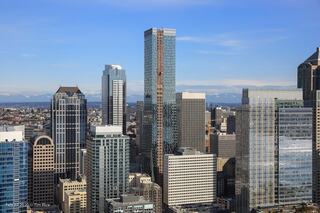Rainier Square Uses PNW’s First Damper System

When it comes to locations for an 850-foot building, you might raise your eyebrows at certain spots over others. There are dozens of considerations….size of site, FAA regulations, seismic conditions, soil quality, and so on. You can imagine that these make designing and building high rises complicated.
Rainier Square’s design certainly had to take all that into account. But there is also one surprising thing that the building’s project team had to take into account: the wind.
All day, every day, the wind batters tall buildings around the world, and they respond by swaying just like a tree. Sometimes, high-rises sway and twist. This movement is not dangerous to the building, but there’s a chance the inhabitants notice the movement, and in extreme cases, could experience motion sickness!!
So, how are these building motions accounted for? One way is to make the structure stronger and more rigid. Another way is to adjust the aerodynamics of the building entirely.
There’s also a third way: dampers. These are common in other parts of the world, like Chicago and Asia, but this is a first in the Northwest! In order to combat wind-induced motion at Rainier Square, Lewis built two “sloshing dampers” on the 59th floor. These are large, concrete rooms that hold thousands of gallons of water. As the building sways one way, the water exerts force in the opposite direction, “damping” the movement.
MKA, the building’s structural engineer, designed the two dampers to be a specific volume and contain baffles inside that moderate the movement of the water. As a result, the movement of the water inside is “tuned” to the exact parameters of Rainer Square’s height, stiffness, wind direction and velocity, and many other data points. When the wind blows and the tower sways, they calm that motion and reduce movement. To show how these work in a simulated environment, MKA created a video to show the effect of the dampers on building movement.
When it comes to locations for an 850-foot building, you might raise your eyebrows at certain spots over others. There are dozens of considerations….size of site, FAA regulations, seismic conditions, soil quality, and so on. You can imagine that these make designing and building high rises complicated.
Rainier Square’s design certainly had to take all that into account. But there is also one surprising thing that the building’s project team had to take into account: the wind.
All day, every day, the wind batters tall buildings around the world, and they respond by swaying just like a tree. Sometimes, high-rises sway and twist. This movement is not dangerous to the building, but there’s a chance the inhabitants notice the movement, and in extreme cases, could experience motion sickness!!
So, how are these building motions accounted for? One way is to make the structure stronger and more rigid. Another way is to adjust the aerodynamics of the building entirely.
There’s also a third way: dampers. These are common in other parts of the world, like Chicago and Asia, but this is a first in the Northwest! In order to combat wind-induced motion at Rainier Square, Lewis built two “sloshing dampers” on the 59th floor. These are large, concrete rooms that hold thousands of gallons of water. As the building sways one way, the water exerts force in the opposite direction, “damping” the movement.
MKA, the building’s structural engineer, designed the two dampers to be a specific volume and contain baffles inside that moderate the movement of the water. As a result, the movement of the water inside is “tuned” to the exact parameters of Rainer Square’s height, stiffness, wind direction and velocity, and many other data points. When the wind blows and the tower sways, they calm that motion and reduce movement. To show how these work in a simulated environment, MKA created a video to show the effect of the dampers on building movement.

In this video, you can see the water moving back and forth in the damper. It is actively calming the motion of the building as it responded to 30-mile-per-hour wind gusts outside by exerting force in the opposite direction of the building motion.
These few inches of water movement represents months, if not years, of collaboration by the Rainier Square project team. So, the next time you’re walking by Rainier Square during one of Seattle’s winter windstorms, look up. If you can see through the driving rain to the top of the tower, remember there’s a feat of building construction and engineering hidden away on the very top floor, actively ensuring that the 58 floors of occupants below aren’t noticing a thing.
